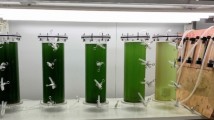Summary
This study examined the microbial degradation of fuel oil by nine highly adapted different commercially available mixed bacterial cultures (DBC-plus™, Flow Laboratories, Meckenheim, F.R.G.) and a bacterial community from a domestic sewage sludge sample. All mixed cultures were cultivated under aerobic batch conditions shaking (110 rpm) at 20°C in a mineral base medium containing 1 or 5% (v/v) fuel oil as the sole carbon source. Percent degradation of fuel oil and the n-alkane fraction was recorded for the nine DBC-plus cultures and the mixed population of the activated sludge sample. The increase in colony counts, protein, and optical density was studied during a 31-day incubation period for DBC-plus culture A, DBC-plus culture A2 and the activated sludge sample. The activated sludge mixed culture was most effective in degrading fuel oil, but various isolated bacterial strains from this bacterial community were not able to grow on fuel oil as the sole carbon source. In contrast, the n-alkane degradation rates of the DBC-cultures were lower, but single strains from the commercially available mixed cultures were able to mineralize fuel oil hydrocarbons. Strains ofPseudomonas aeruginosa were isolated most frequently and these organisms were able to grow very rapidly on fuel oil as a complex sole carbon source. The results indicate that fuel oil degradation in domestic sewage sludge is performed by mixed populations of naturally occurring bacteria and does not depend on the application of highly adapted commercially available cultures.
Similar content being viewed by others
References
Atlas, R.M. 1977. Stimulated petroleum degradation. CRC Crit. Rev. Microbiol. 5: 371–386.
Atlas, R.M. 1978. Microorganisms and petroleum pollutants. Bioscience 28: 387–391.
Atlas, R.M. 1981. Microbial degradation of petroleum hydrocarbons: an environmental perspective. Microb. Rev. 45: 180–209.
Bartha, R. 1986. Biotechnology of Petroleum Biodegradation. Microb. Ecol. 12: 155–172.
Bartha, R. and R.M. Atlas 1977. The microbiology of aquatic oil spills. Adv. Appl. Microbiol. 22: 225–266.
Britton, L.N. 1984. Microbial degradation of aliphatic hydrocarbons. In: Microbial degradation of organic compounds. (Gibson, D.T., ed.), pp. 89–129, Marcel Dekker, Inc., New York and Basel.
Dott, W. and P. Kämpfer 1988. Biochemical methods for automated bacterial identification and testing metabolic activities in water and wastewater. Water Sci. Technol. 20: 221–227.
Gibson, D.T. and V. Subramanian 1984. Microbial degradation of aromatic hydrocarbons. In: Microbial degradation of organic compounds. (Gibson, D.T., ed.), pp. 181–252, Marcel Dekker, Inc., New York and Basel.
Herbert, D., P.J. Phipps and R.E. Strange 1971. Chemical analysis of microbial cells. In: Methods in Microbiology, Vol. 5B (Norris, J.R. and D.W. Ribbons, eds.), pp. 210–344, Academic Press, New York and London.
Lethomaki, M. and S. Niemelä 1975. Improving microbial degradation of oil in soil. Ambio 4: 126–129.
Perry, J.J. 1977. Microbial metabolism of cyclic hydrocarbons and related compounds. Crit. Rev. Microbiol. 5: 387–412.
Perry, J.J. 1979. Microbial cooxidations involving hydrocarbons. Microb. Rev. 43: 59–72.
Pfennig, N. and K.D. Lippert 1966. Über das Vitamin B12 Bedürfnis phototropher Schwefelbakterien. Arch. Microbiol. 55: 245–256.
Taggers, S., A. Bianchi, M. Juillard, J. Le Petit and B. Roux 1983. Effects of microbial seeding of crude oil in seawater in a model system. Marine Biology 78: 13–20.
Trudgill, P.W. 1984. Microbial degradation of the alicyclic ring. In: Microbial degradation of organic compounds. (Gibson, D.T., ed.), pp. 131–180, Marcel Dekker, Inc., New York and Basel.
Zajic, J.E., B. Supplisson and B. Volesky 1974. Bacterial degradation and emulsification of No. 6 fuel oil. Env. Sci. Technol. 8: 664–668.
Author information
Authors and Affiliations
Rights and permissions
About this article
Cite this article
Dott, W., Feidieker, D., Kämpfer, P. et al. Comparison of autochthonous bacteria and commercially available cultures with respect to their effectiveness in fuel oil degradation. Journal of Industrial Microbiology 4, 365–373 (1989). https://doi.org/10.1007/BF01569538
Received:
Accepted:
Issue Date:
DOI: https://doi.org/10.1007/BF01569538




